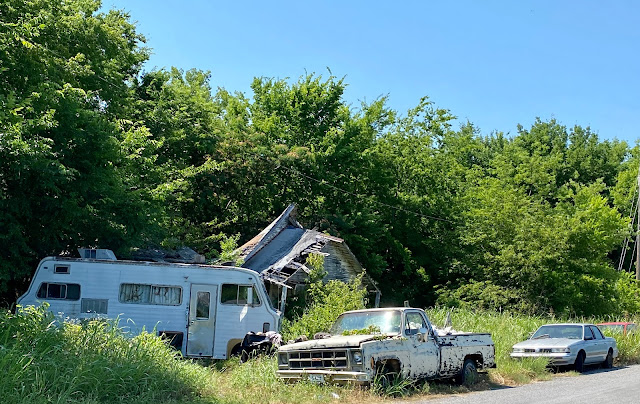I knew a great deal about the Indian Removal Act before I went on my Summer 2021 Sojourn. I can also say I maybe knew a little about Indigenous folk being slave owners in the South. Just as I knew about Indian "Praying Towns" up North.
These were all a part of the "civilizing" of the "savages" (borrowed terms, not mine); Native folk acquiring the customs and ways of the white folk. Religious conversion I can maybe understand (and in fact really admire some of the blended spiritual practices that modern Indigenous Christian churches have), but I will never be okay with and/or understand the whole slave-owning thing, no matter who was enslaving whom.
So this new learning was something I wanted to poke around in for a bit. Much has been said, uncovered, and exposed about the tragedy-atrocity of what happened in Tulsa's vibrant black community (Greenwood District) in 1921, but I did not know that there were other small little all black or all red or even black and red mixed communities. I sought these spaces out.
TAFT OKLAHOMA
The Land Rush of 1889 in Oklahoma is trippy history. People literally lined up (about 50,000 of them) to get a piece of "unoccupied public land" (debating this is for another day) also known as "non-Indian settlement in sections of Indian Territory." There were "Black Boomers" or "Pioneers" were among the crowd of grabbers. They staked claims, created communities and called the soon-to-be state of Oklahoma (1907) home.
Taft started as an all-black town allotted to the freedmen of the Creek Nation. Yup, you read correctly. You know that long trail of tears that Indigenous folks took from the East to the West? Well apparently some of those folks were not only trailing tears, but were trailing slaves as well! Learning this really blew my mind. The complexities of our country are vast and extremely difficult to deconstruct. What did these "freed" people think of their enslavers? What did these Indigenous people think of outsiders coming to grab the very land they were forced onto?
I think for most blacks they saw this time as and event as opportunity to strike out on their own. And they did!
Between 1856 and 1920 more than 50 all-black towns were founded. Today, there are only 13 of these towns left in Oklahoma. We decided to visit Taft.
On our list (because I have a curious mind for how we treat folks with mental health issues) was the State Hospital for Negroes.
In 1932, Taft State Hospital was 1 of 7 psychiatric hospitals in the US exclusively for "insane and idiotic negroes."
From the: STATE OF OKLAHOMA ANNUAL REPORT 1956
TAFT STATE HOSPITAL Population: 812 Male 410 Female 402
LOCATION: This institution is located at Taft, Muskogee County, Oklahoma, on Highway 62 and 64. Taft has an exclusive population of 700 colored people.
TYPE OF INSTITUTION: Taft State Hospital is an institution for the treatment and care of mentally ill and mentally retarded Negroes. Because all types of mental disorders are treated here, the patient population is made up of all age groups. This is the only mental hospital for colored patients in Oklahoma.
HISTORY: The hospital building was begun in the year 1932, during the administration of Governor William H. Murray. The original hospital consisted of one building approximately one-fourth mile in length, divided into 10 wards and 4 infirmaries, with the center portion of the building being used for administrative offices and dormitories for the employees. The building was completed in the year 1933 and was formally opened March 15, 1934. The patients were admitted by transfer from Central State Hospital, Norman, Oklahoma April 1, 1934. During the year 1951 new buildings were added, the money for the building was obtained from former Governor Roy J. Turner's Bond Issue Program. These buildings are as follows: Nurses Home, Henry Hall, Mental Retarded School and classrooms. Occupational Therapy Building and Medical Center. The medical center consists of five wards which are sub-divided into cubicles-doctor's offices, examination rooms, drug room, x-ray, dental offices, operating room and accessory rooms.
DEAF, BLIND AND ORPHAN INSTITUTION Taft, Oklahoma Population: 212
TYPE OF INSTITUTION: This institution is a home for dependent, neglected deaf, blind and orphan Negro children, under the age of eighteen years. The school for the deaf and blind Negro children is a section of this institution. The age distribution is from infancy to eighteen years.
As we drove into town this is what we saw:
We were a bit confused because it was close to the address we were looking for. So the rest of the story goes:So we did the next best thing, which was to make a right turn on the only side street around. It was a tiny piece of street named Grant that was an un-named dead ender and at the end this is what we saw (hubby became very anxious when a black woman stepped out on her doorstep and just stared at us.
What on earth was this??? Is it still something or vacant?
2010 population: 250
The sign must be dated a bit, as the population figure is incorrect. Also, although Ms. Davis is still alive, she is not currently mayor. Also her election and "first" status predated another black female "Davis" mayor (Doris Davis of Compton, CA later in the same year, 1973).
I sure wondered where those bricks came from. No loose ones in sight.
Not sure if because of the Pandemic or not, but not one person out walking around.
It was eerily quiet.
The Boot Cafe, the one store in town, didn't seem to be open.
Not sure if the Masonic Temple actually operating. Things look pretty old and faded.
A few shotgun-type houses seemed occupied.

...and other things clearly are abandoned.




















No comments:
Post a Comment